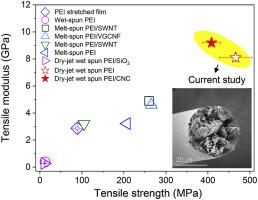当前位置:
X-MOL 学术
›
Compos. Sci. Technol.
›
论文详情
Our official English website, www.x-mol.net, welcomes your feedback! (Note: you will need to create a separate account there.)
The effect of cellulose nanocrystals (CNCs) on the microstructure of amorphous polyetherimide (PEI)-based nanocomposite fibers and its correlation with the mechanical properties
Composites Science and Technology ( IF 9.1 ) Pub Date : 2020-11-01 , DOI: 10.1016/j.compscitech.2020.108452 Jung-Eun Lee , Yea Eun Kim , Ga-Hyeun Lee , Min Jeong Kim , Youngho Eom , Han Gi Chae
Composites Science and Technology ( IF 9.1 ) Pub Date : 2020-11-01 , DOI: 10.1016/j.compscitech.2020.108452 Jung-Eun Lee , Yea Eun Kim , Ga-Hyeun Lee , Min Jeong Kim , Youngho Eom , Han Gi Chae

|
Abstract Polyetherimide (PEI) and PEI/cellulose nanocrystal (CNC) fibers are dry-jet wet-spun in a draw ratio (DR) range of 2.8–7. The effect of CNC concentration (0–5 wt% with respect to polymer) on the mechanical and structural properties is also studied. At a DR of 7, control PEI fibers exhibit 466 MPa and 8.1 GPa of tensile strength and modulus, while those of PEI/CNC3 fibers are 409 MPa and 9.2 GPa, respectively, which are among the best properties reported so far for PEI-based materials. The tensile strengths of CNC-containing fibers are inferior to that of the control fiber. On the contrary, the PEI/CNC nanocomposite fibers show improved tensile moduli. Although the improvement in tensile moduli of polymer fibers by incorporating nanofillers is well-known phenomenon, the structural analysis reveals interesting orientation behavior of CNCs and PEI chains. The CNCs are readily aligned along the fiber axis due to their fibrillar morphology, and show a high degree of orientation in the as-spun fibers (fCNC, as-spun = 0.63), which can be further aligned upon drawing (fCNC, drawn = 0.75), whereas the PEI chains exhibit a low degree of orientation even at the maximum extent of drawing (fPEI, composite drawn = 0.10). This is even lower than that in the control fiber (fPEI, control drawn = 0.22), suggesting that the CNCs disturb PEI alignment despite of strong hydrogen bond between them.
中文翻译:

纤维素纳米晶(CNCs)对无定形聚醚酰亚胺(PEI)基纳米复合纤维微观结构的影响及其与力学性能的相关性
摘要 聚醚酰亚胺 (PEI) 和 PEI/纤维素纳米晶 (CNC) 纤维采用干喷湿法纺丝,拉伸比 (DR) 范围为 2.8-7。还研究了 CNC 浓度(相对于聚合物为 0-5 wt%)对机械和结构性能的影响。在 DR 为 7 时,对照 PEI 纤维的拉伸强度和模量分别为 466 MPa 和 8.1 GPa,而 PEI/CNC3 纤维的拉伸强度和模量分别为 409 MPa 和 9.2 GPa,这是迄今为止报道的基于 PEI 的最佳性能之一材料。含CNC纤维的抗拉强度不如对照纤维。相反,PEI/CNC 纳米复合纤维显示出改进的拉伸模量。虽然通过掺入纳米填料改善聚合物纤维的拉伸模量是众所周知的现象,结构分析揭示了 CNC 和 PEI 链的有趣定向行为。由于它们的原纤维形态,CNC 很容易沿纤维轴对齐,并且在初纺纤维中显示出高度的取向 (fCNC, as-spun = 0.63),可以在拉伸时进一步对齐 (fCNC, 0.75),而 PEI 链即使在最大拉伸范围内也表现出低取向度(fPEI,复合拉伸 = 0.10)。这甚至低于控制纤维(fPEI,控制拉伸 = 0.22),这表明 CNC 干扰 PEI 对齐,尽管它们之间存在强氢键。绘制 = 0.75),而 PEI 链即使在最大拉伸范围内也表现出低取向度(fPEI,复合绘制 = 0.10)。这甚至低于控制纤维(fPEI,控制拉伸 = 0.22),这表明 CNC 干扰 PEI 对齐,尽管它们之间存在强氢键。绘制 = 0.75),而 PEI 链即使在最大拉伸范围内也表现出较低的取向度(fPEI,复合绘制 = 0.10)。这甚至低于控制纤维(fPEI,控制拉伸 = 0.22),这表明 CNC 干扰 PEI 对齐,尽管它们之间存在强氢键。
更新日期:2020-11-01
中文翻译:

纤维素纳米晶(CNCs)对无定形聚醚酰亚胺(PEI)基纳米复合纤维微观结构的影响及其与力学性能的相关性
摘要 聚醚酰亚胺 (PEI) 和 PEI/纤维素纳米晶 (CNC) 纤维采用干喷湿法纺丝,拉伸比 (DR) 范围为 2.8-7。还研究了 CNC 浓度(相对于聚合物为 0-5 wt%)对机械和结构性能的影响。在 DR 为 7 时,对照 PEI 纤维的拉伸强度和模量分别为 466 MPa 和 8.1 GPa,而 PEI/CNC3 纤维的拉伸强度和模量分别为 409 MPa 和 9.2 GPa,这是迄今为止报道的基于 PEI 的最佳性能之一材料。含CNC纤维的抗拉强度不如对照纤维。相反,PEI/CNC 纳米复合纤维显示出改进的拉伸模量。虽然通过掺入纳米填料改善聚合物纤维的拉伸模量是众所周知的现象,结构分析揭示了 CNC 和 PEI 链的有趣定向行为。由于它们的原纤维形态,CNC 很容易沿纤维轴对齐,并且在初纺纤维中显示出高度的取向 (fCNC, as-spun = 0.63),可以在拉伸时进一步对齐 (fCNC, 0.75),而 PEI 链即使在最大拉伸范围内也表现出低取向度(fPEI,复合拉伸 = 0.10)。这甚至低于控制纤维(fPEI,控制拉伸 = 0.22),这表明 CNC 干扰 PEI 对齐,尽管它们之间存在强氢键。绘制 = 0.75),而 PEI 链即使在最大拉伸范围内也表现出低取向度(fPEI,复合绘制 = 0.10)。这甚至低于控制纤维(fPEI,控制拉伸 = 0.22),这表明 CNC 干扰 PEI 对齐,尽管它们之间存在强氢键。绘制 = 0.75),而 PEI 链即使在最大拉伸范围内也表现出较低的取向度(fPEI,复合绘制 = 0.10)。这甚至低于控制纤维(fPEI,控制拉伸 = 0.22),这表明 CNC 干扰 PEI 对齐,尽管它们之间存在强氢键。



























 京公网安备 11010802027423号
京公网安备 11010802027423号